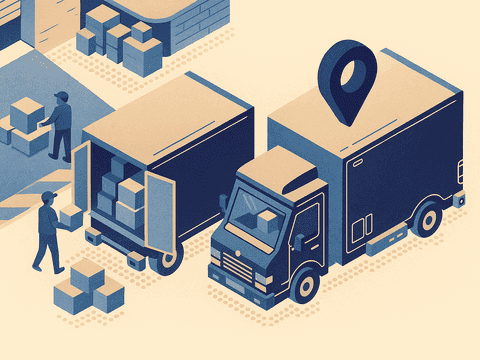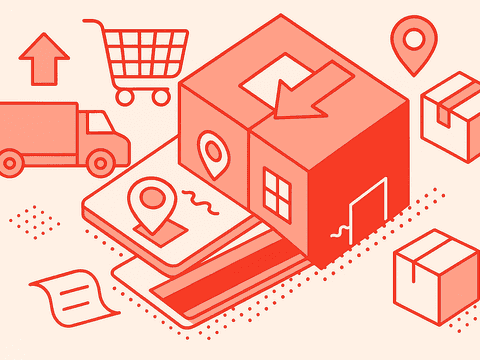TL,DR:
- At enterprise scale, shipping success hinges on a global software that rolls every parcel, mailing task, multi-carrier routing, and live tracking into one unified system
- When that system shares real-time costs and status with Customer Service, Finance, Ops, and leadership, the whole company benefits from data-driven decisions instead of siloed guesswork
- Rising errors, manual data entry, or pricey peak seasons signal it’s time for a best-in-class multi carrier solution
- Outvio is the best enterprise shipping solution for high-growth eCommerce brands that want to automate the entire post-purchase experience
Managing shipping at the enterprise level comes with serious challenges: more orders, more carriers, more rules, and higher customer expectations. To stay in control, you need an enterprise shipping solution that truly automates your mailing and carrier management—both regionally and internationally.
However, the enterprise shipping market is projected to grow at a compound annual growth rate (CAGR) of 12% from 2024 to 2030, reaching USD 194.89 million by 2030. That means new software, systems, and platforms are emerging every day to help manage enterprise shipping operations—but which one is the best? Which should you choose?
In this article, we’ll break down some of the best tools available.
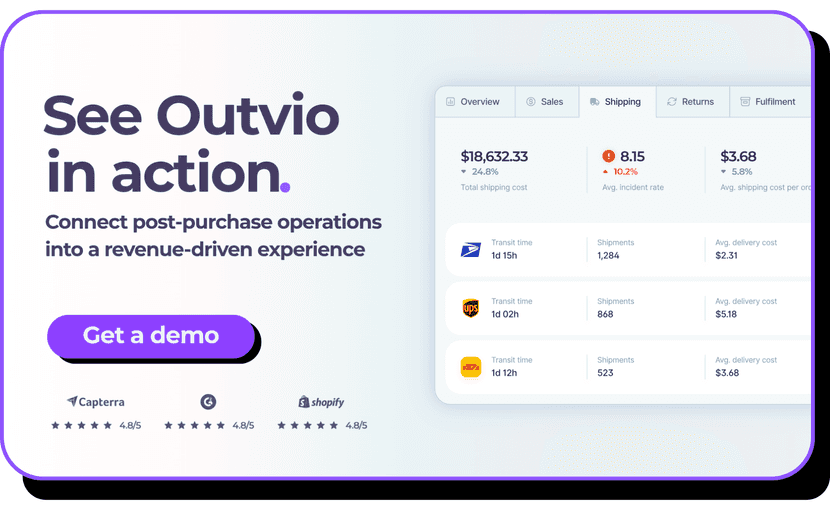
Top-rated enterprise solutions for 2025
| Software | Best for | G2 Rating | Pricing* |
|---|---|---|---|
| Outvio | All-in-one post-checkout automation—labels, tracking, returns and support—for high-growth eCommerce brands | 4.8 | Custom |
| Metapack | High-volume retailers that need rule-based carrier selection and sub-300 ms label generation | 3.8 | Contact sales |
| Shipengine | Developer-centric API to embed multi-carrier labels, rate shopping and tracking into any platform | 3.5 | From $69 / month |
| nShift | Large logistics operations (especially in Northern Europe) requiring end-to-end carrier integration and returns | 4.0 | Contact sales |
| Shippo | Fast, plug-and-play multi-carrier shipping for SMBs and mid-market businesses expanding internationally | 4.3 | From $19 / month (200 labels) |
| Easypost | API-first carrier connectivity with address verification, customs docs and scan-based returns | 4.2 | Contact sales |
| Project44 | Real-time multimodal visibility and predictive ETAs for complex enterprise supply chains | 4.7 | Contact sales |
What is enterprise shipping?
Enterprise shipping is the discipline that weaves shipping logistics into corporate strategy: every package, cost and carrier is managed under common business rules and shared in real time across all areas of the company, turning transportation from an isolated operating expense into a driver of service and profitability.
What is enterprise shipping software?
Enterprise shipping software is a global, multi-carrier solution that elevates every parcel and mailing move to a company-wide discipline.
The system blends planning, business rules, rate shopping and real-time tracking so anyone with the right permissions, from customer service to the CEO, gets instant insight into cost, status and volume trends.
The best enterprise shipping solutions scale effortlessly with growth, slot into your tech stack more easily than a WMS or ERP, and automate rules as basic as “ship it UPS” or as intricate as “if it’s Friday, customer 123 receives FedEx Saturday Delivery for orders over €750 in Q4.
Who wins with this kind of software?
- Customer Service answers “Where’s my parcel?” in seconds with live tracking links
- Accounting & Finance see negotiated vs. published rates and allocate shipping costs accurately
- Warehouse & Operations cut label time, print multi-carrier documentation from one screen and spot volume trends
- Sales & Marketing promise faster, cheaper delivery options that boost conversion
- IT manages a single, future-proof platform instead of juggling point solutionsz
- Executives gain global performance dashboards for carrier negotiations and strategic decisions
- Customers ultimately receive shipments faster, with predictable costs and transparent updates, driving loyalty and repeat business
Signs you need an enterprise multi carrier shipping software
Excessive manual processes
If your team heavily relies on manual data entry or resolving delivery exceptions, it's a clear indicator that your current system is inefficient.
Frequent shipping errors
An increase in mislabeled packages, incorrect addresses, or delayed deliveries suggests that your system lacks adequate safeguards.
Rising shipping costs
Outdated systems can hinder the optimization of carrier selection or the negotiation of volume discounts, leading to unnecessary expenses.
Difficulty scaling during peak demand
If your system struggles to handle increased order volumes during peak seasons, it's likely limiting your growth potential.
7 best enterprise parcel shipping software
1. Outvio
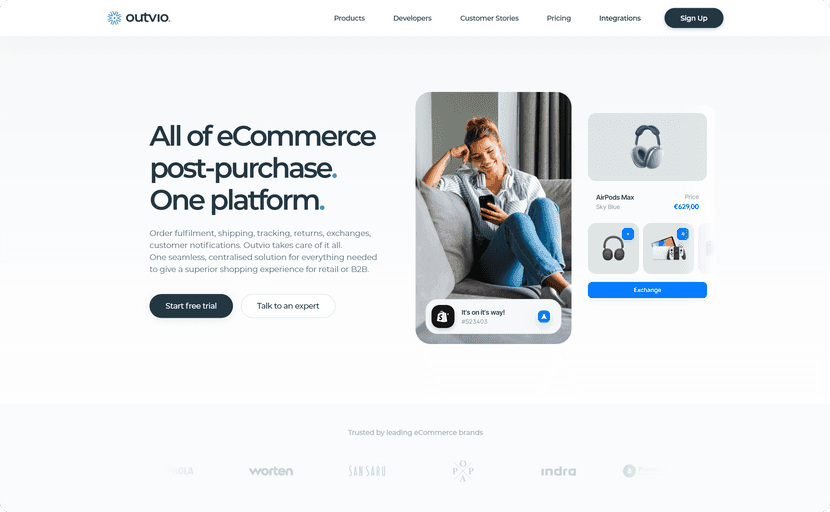
G2 Rating: 4.8
Outvio is an all-in-one shipping platform for enterprise eCommerce brands that need full control. It automates everything happen after checkout: fulfillment, tracking, support, returns and carrier management.
Outvio also allows you to create a branded enterprise tracking experience, turning your shipments and orders into marketing channels that truly drive sales and revenue.
Key benefits
- Connect with 100+ carriers and automate label generation, tracking, and carrier selection
- Automatically generate necessary customs forms and commercial invoices for international shipments and without errors
- Let customers process returns, exchanges, or store credit automatically with custom rules by SKU, country, reason, etc
- Handle support tickets, order inquiries, and delivery issues in one place with a helpdesk built for eCommerce
- Promote products in tracking pages, return flows, and post-purchase messages to increase AOV
Pricing: Custom
2. Metapack
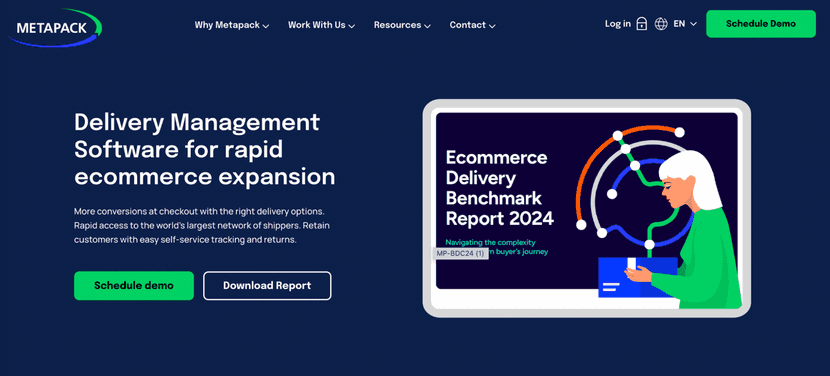
G2 Rating: 3.8
Metapack is a powerful enterprise delivery management platform used by global retailers. It offers access to hundreds of carriers and delivery services, with tools to optimize cost and performance.
Key benefits:
- Automated carrier selection based on rules like delivery time, cost, weight, and destination, ensuring optimal service allocation
- Rapid label generation with response times under 300ms, facilitating high-volume order processing
- Customs documentation and manifest creation for international shipments, streamlining cross-border logistics
Starting price: Contact sales
3. Shipengine
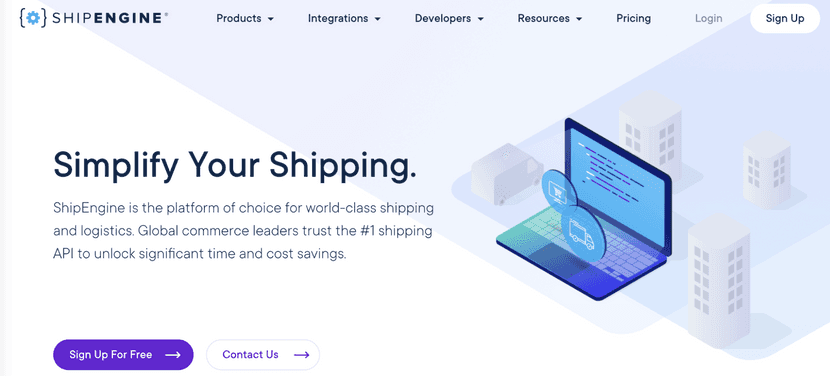
G2 Rating: 3.5
Shipengine is a shipping API built for developers. It powers shipping functionality in many platforms by providing label creation, rate comparison, tracking, and address validation across carriers
Key benefits:
- Access 100+ carriers worldwide to compare rates, print labels, and track shipments via API
- Get real-time shipping rates from multiple carriers to choose the best option based on cost and speed
- Track shipments across carriers with unified tracking and webhooks for real-time status updates
Starting price: $69/month
4. nShift
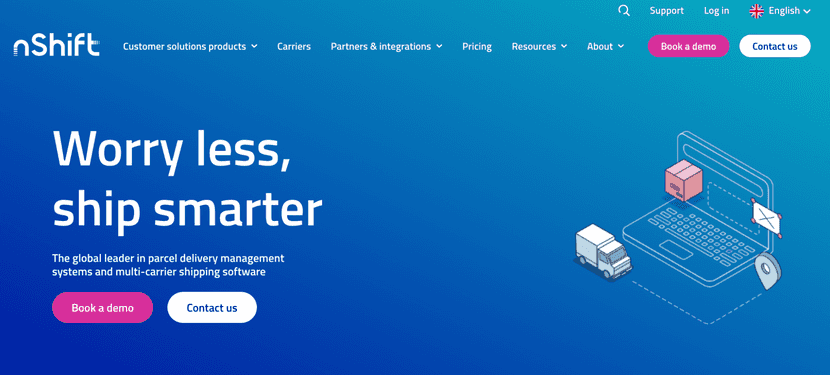
G2 Rating: 4
nShift is a enterprise shipping platform designed for large-scale logistics operations. It offers carrier integration, label generation, tracking, and returns across multiple countries and platforms. A very popular system in Northern Europe.
Key benefits:
- Monitors packages from arrival to final delivery, ensuring transparency and reducing the chances of lost items
- Allows customizable access levels, enabling different departments (e.g., front desk, concierge) to view or manage package information as needed
- Accessible via web portal and mobile devices, allowing staff to manage packages on-the-go
Starting price: Contact sales
5. Shippo
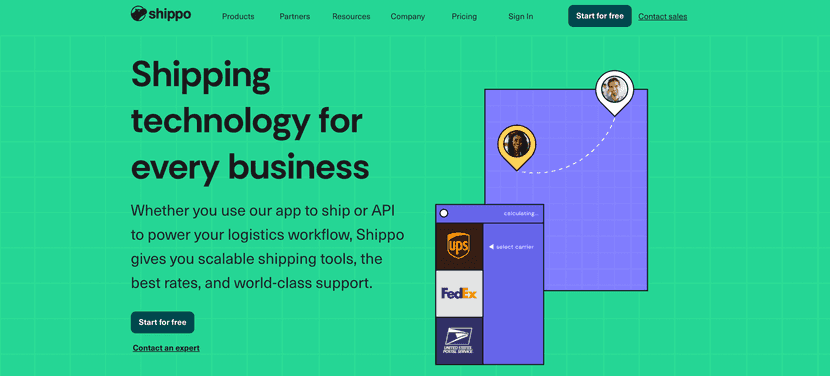
G2 Rating: 4.3
Shippo provides multi-carrier enterprise shipping software and APIs. It’s ideal for businesses that need fast integration with global carriers, rate shopping, and streamlined label generation.
Key benefits:
- Access discounted rates from over 40 global carriers, including USPS, UPS, FedEx, and DHL Express
- Automate shipping processes with customizable rules and workflows
- Connect with various tools and marketplaces to centralize order and shipping management
Starting price: $19/month (up to 200 monthly labels)
6. Easypost

G2 Rating: 4.2
Easypost is an API-first solution that simplifies carrier integration and shipping automation. It supports address verification, parcel tracking, rate comparison, and insurance across major global carriers.
Key benefits:
- Generate shipping labels individually or in batches, streamlining the fulfillment process
- Simplify the returns process with scan-based return labels, enhancing customer satisfaction
- Automatically generate necessary customs forms and commercial invoices for international shipments
Starting price: Contact sales
7. Project44

G2 Rating: 4.7
Project44 is focused on real-time supply chain visibility. It connects shippers with carriers, offering tracking and logistics data across ocean, rail, truckload, and last-mile delivery to improve ETAs and reduce delays.
Key benefits:
- Tracks shipments at the SKU and order level, enabling precise inventory management and proactive exception handling
- Automates yard operations, including appointment scheduling and gate check-ins, to reduce dwell times and improve efficiency
- Provides real-time visibility into assets within facilities, aiding in inventory control and resource allocation
Starting price: Contact sales
Outvio, the best enterprise software solution for global shipping
Most enterprise shiping tools handle logistics in silos. Outvio connects every shipping touchpoint — from checkout to carrier performance — into one seamless ecosystem. Gain full visibility over your operations, optimize carrier usage, and deliver a superior post-purchase experience at scale.
Static delivery experiences don’t build loyalty. Outvio turns every shipment into a chance to engage, sell more, and bring customers back. Kerli Reinholm, Marketing Manager at Skechers.
Find out why Outvio is the best enterprise shipping solution. Book a demo.


